Business Economics Report: Macroeconomic Policies and Canada
VerifiedAdded on 2022/08/25
|7
|1426
|24
Report
AI Summary
This report delves into the application of fiscal and monetary policies to mitigate economic slowdowns, with a specific focus on the Canadian economy. It begins by outlining the global economic risks and the projected slower growth rate, followed by an analysis of how tax cuts and monetary policy, specifically interest rate adjustments by the Bank of Canada, can be employed to stimulate economic activity. The report explores the impact of these policies on employment, consumer spending, and GDP growth, emphasizing the importance of monitoring business spending and hiring activity. It concludes by highlighting the interconnectedness of macroeconomic factors and the role of fiscal and monetary tools in preventing recession and fostering economic stability. The report references various academic sources to support its arguments, providing a comprehensive overview of the topic.
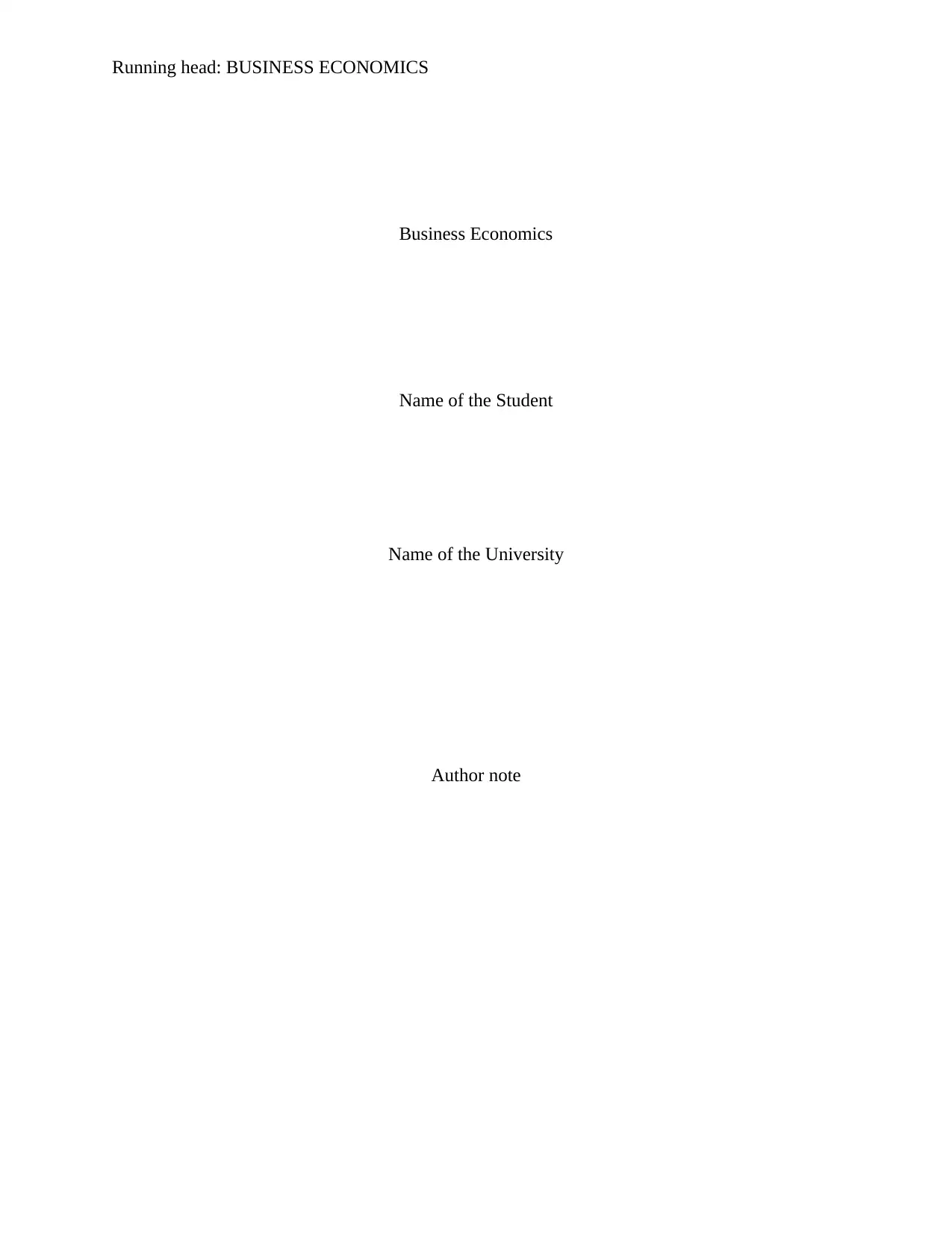
Running head: BUSINESS ECONOMICS
Business Economics
Name of the Student
Name of the University
Author note
Business Economics
Name of the Student
Name of the University
Author note
Paraphrase This Document
Need a fresh take? Get an instant paraphrase of this document with our AI Paraphraser
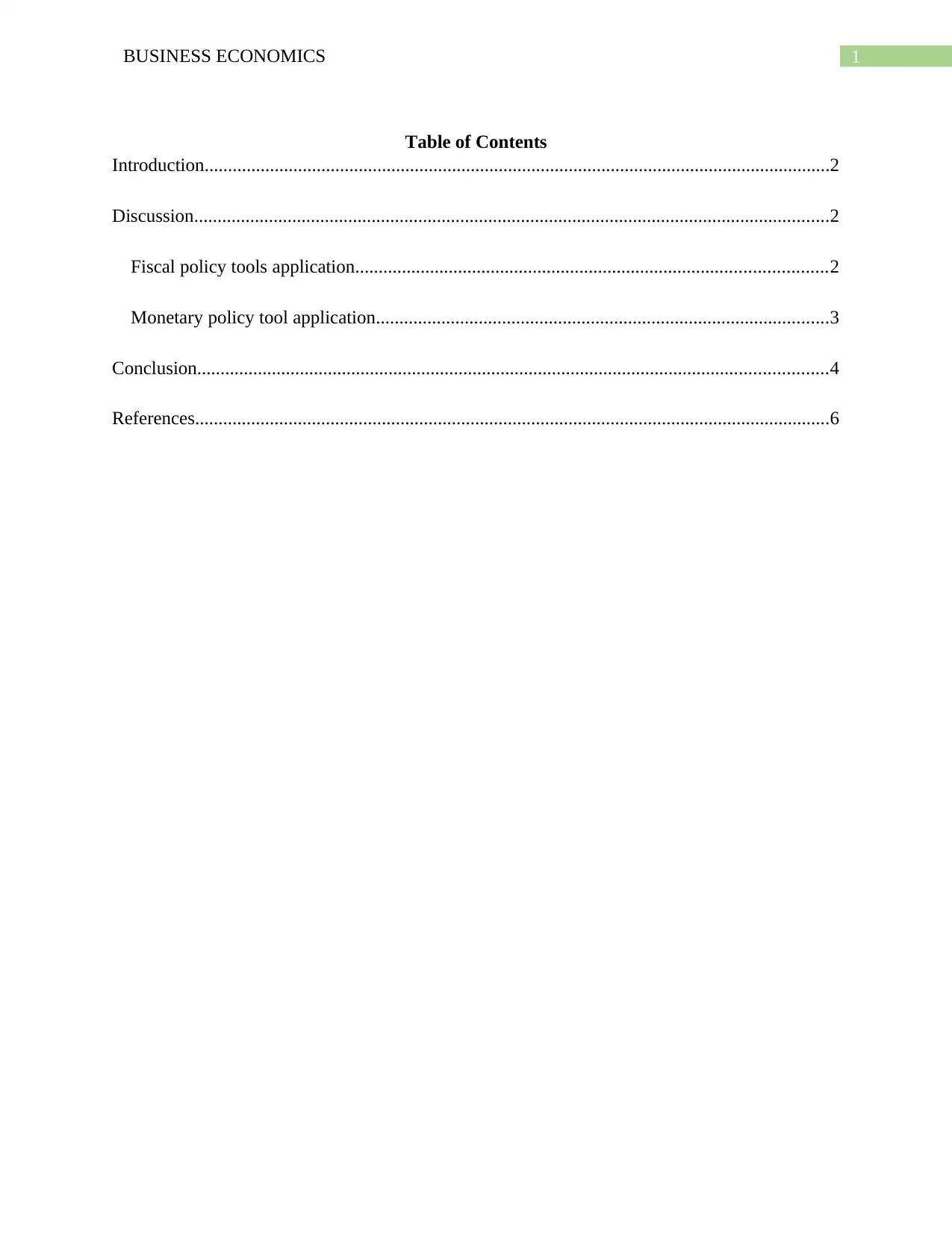
1BUSINESS ECONOMICS
Table of Contents
Introduction......................................................................................................................................2
Discussion........................................................................................................................................2
Fiscal policy tools application.....................................................................................................2
Monetary policy tool application.................................................................................................3
Conclusion.......................................................................................................................................4
References........................................................................................................................................6
Table of Contents
Introduction......................................................................................................................................2
Discussion........................................................................................................................................2
Fiscal policy tools application.....................................................................................................2
Monetary policy tool application.................................................................................................3
Conclusion.......................................................................................................................................4
References........................................................................................................................................6
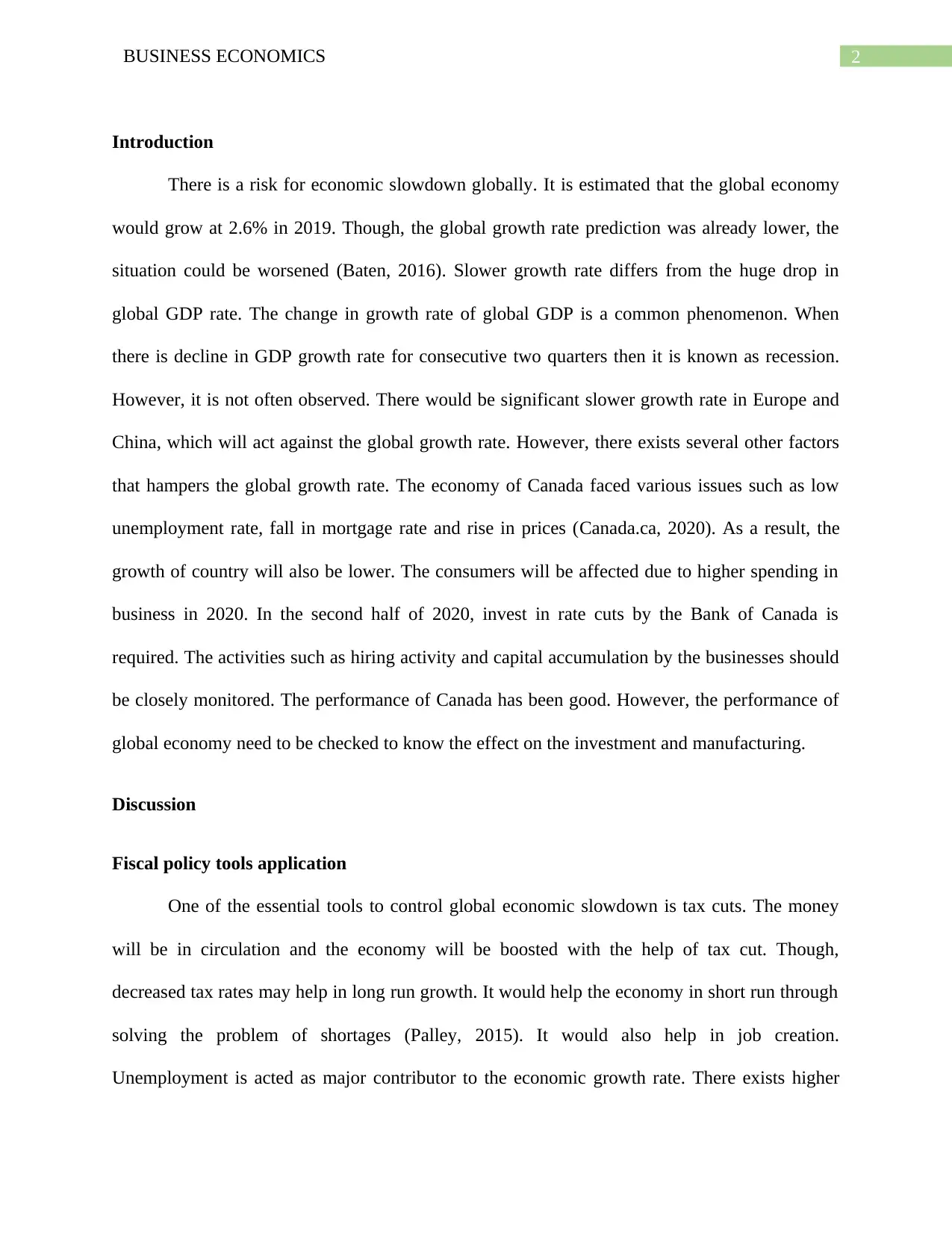
2BUSINESS ECONOMICS
Introduction
There is a risk for economic slowdown globally. It is estimated that the global economy
would grow at 2.6% in 2019. Though, the global growth rate prediction was already lower, the
situation could be worsened (Baten, 2016). Slower growth rate differs from the huge drop in
global GDP rate. The change in growth rate of global GDP is a common phenomenon. When
there is decline in GDP growth rate for consecutive two quarters then it is known as recession.
However, it is not often observed. There would be significant slower growth rate in Europe and
China, which will act against the global growth rate. However, there exists several other factors
that hampers the global growth rate. The economy of Canada faced various issues such as low
unemployment rate, fall in mortgage rate and rise in prices (Canada.ca, 2020). As a result, the
growth of country will also be lower. The consumers will be affected due to higher spending in
business in 2020. In the second half of 2020, invest in rate cuts by the Bank of Canada is
required. The activities such as hiring activity and capital accumulation by the businesses should
be closely monitored. The performance of Canada has been good. However, the performance of
global economy need to be checked to know the effect on the investment and manufacturing.
Discussion
Fiscal policy tools application
One of the essential tools to control global economic slowdown is tax cuts. The money
will be in circulation and the economy will be boosted with the help of tax cut. Though,
decreased tax rates may help in long run growth. It would help the economy in short run through
solving the problem of shortages (Palley, 2015). It would also help in job creation.
Unemployment is acted as major contributor to the economic growth rate. There exists higher
Introduction
There is a risk for economic slowdown globally. It is estimated that the global economy
would grow at 2.6% in 2019. Though, the global growth rate prediction was already lower, the
situation could be worsened (Baten, 2016). Slower growth rate differs from the huge drop in
global GDP rate. The change in growth rate of global GDP is a common phenomenon. When
there is decline in GDP growth rate for consecutive two quarters then it is known as recession.
However, it is not often observed. There would be significant slower growth rate in Europe and
China, which will act against the global growth rate. However, there exists several other factors
that hampers the global growth rate. The economy of Canada faced various issues such as low
unemployment rate, fall in mortgage rate and rise in prices (Canada.ca, 2020). As a result, the
growth of country will also be lower. The consumers will be affected due to higher spending in
business in 2020. In the second half of 2020, invest in rate cuts by the Bank of Canada is
required. The activities such as hiring activity and capital accumulation by the businesses should
be closely monitored. The performance of Canada has been good. However, the performance of
global economy need to be checked to know the effect on the investment and manufacturing.
Discussion
Fiscal policy tools application
One of the essential tools to control global economic slowdown is tax cuts. The money
will be in circulation and the economy will be boosted with the help of tax cut. Though,
decreased tax rates may help in long run growth. It would help the economy in short run through
solving the problem of shortages (Palley, 2015). It would also help in job creation.
Unemployment is acted as major contributor to the economic growth rate. There exists higher
⊘ This is a preview!⊘
Do you want full access?
Subscribe today to unlock all pages.

Trusted by 1+ million students worldwide
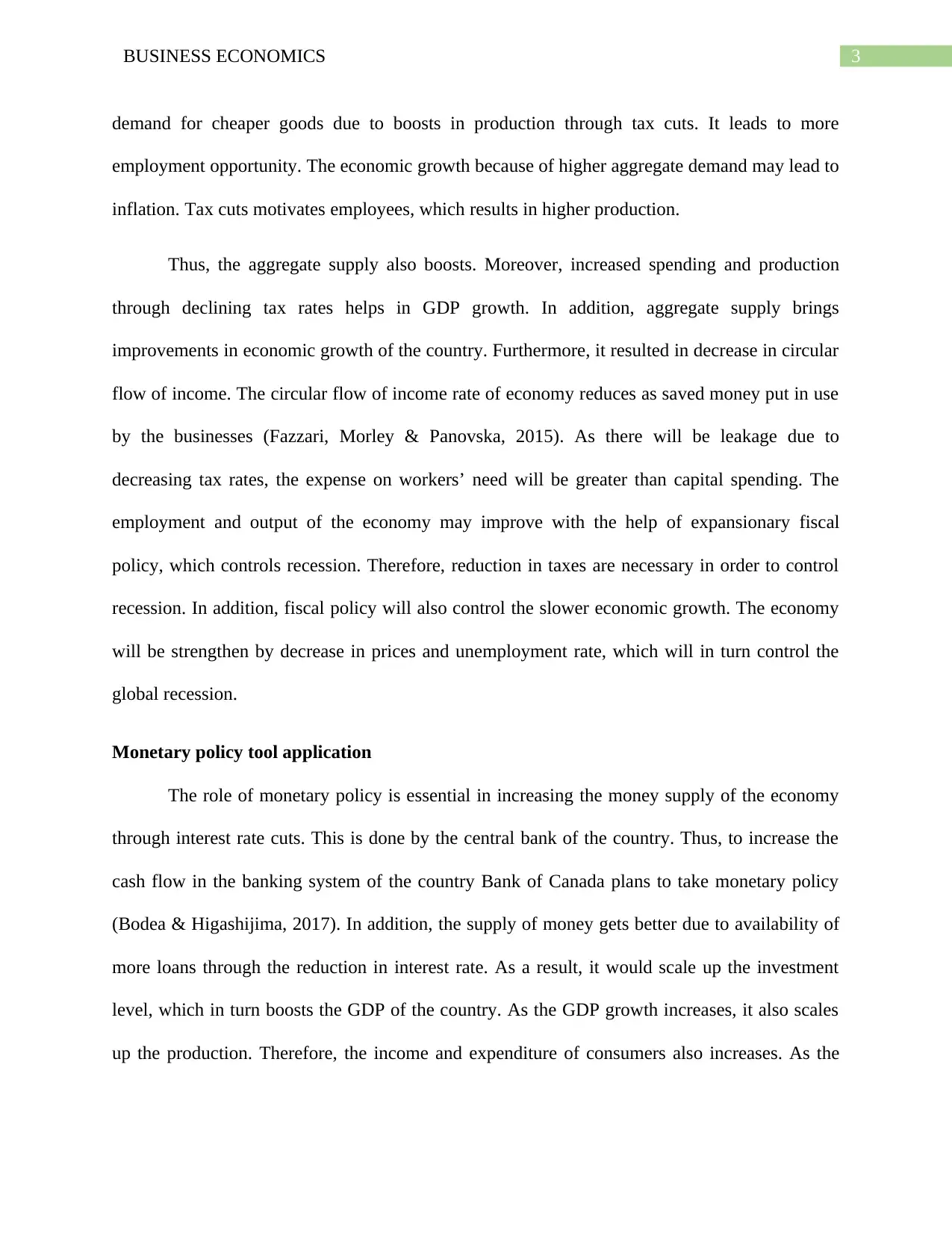
3BUSINESS ECONOMICS
demand for cheaper goods due to boosts in production through tax cuts. It leads to more
employment opportunity. The economic growth because of higher aggregate demand may lead to
inflation. Tax cuts motivates employees, which results in higher production.
Thus, the aggregate supply also boosts. Moreover, increased spending and production
through declining tax rates helps in GDP growth. In addition, aggregate supply brings
improvements in economic growth of the country. Furthermore, it resulted in decrease in circular
flow of income. The circular flow of income rate of economy reduces as saved money put in use
by the businesses (Fazzari, Morley & Panovska, 2015). As there will be leakage due to
decreasing tax rates, the expense on workers’ need will be greater than capital spending. The
employment and output of the economy may improve with the help of expansionary fiscal
policy, which controls recession. Therefore, reduction in taxes are necessary in order to control
recession. In addition, fiscal policy will also control the slower economic growth. The economy
will be strengthen by decrease in prices and unemployment rate, which will in turn control the
global recession.
Monetary policy tool application
The role of monetary policy is essential in increasing the money supply of the economy
through interest rate cuts. This is done by the central bank of the country. Thus, to increase the
cash flow in the banking system of the country Bank of Canada plans to take monetary policy
(Bodea & Higashijima, 2017). In addition, the supply of money gets better due to availability of
more loans through the reduction in interest rate. As a result, it would scale up the investment
level, which in turn boosts the GDP of the country. As the GDP growth increases, it also scales
up the production. Therefore, the income and expenditure of consumers also increases. As the
demand for cheaper goods due to boosts in production through tax cuts. It leads to more
employment opportunity. The economic growth because of higher aggregate demand may lead to
inflation. Tax cuts motivates employees, which results in higher production.
Thus, the aggregate supply also boosts. Moreover, increased spending and production
through declining tax rates helps in GDP growth. In addition, aggregate supply brings
improvements in economic growth of the country. Furthermore, it resulted in decrease in circular
flow of income. The circular flow of income rate of economy reduces as saved money put in use
by the businesses (Fazzari, Morley & Panovska, 2015). As there will be leakage due to
decreasing tax rates, the expense on workers’ need will be greater than capital spending. The
employment and output of the economy may improve with the help of expansionary fiscal
policy, which controls recession. Therefore, reduction in taxes are necessary in order to control
recession. In addition, fiscal policy will also control the slower economic growth. The economy
will be strengthen by decrease in prices and unemployment rate, which will in turn control the
global recession.
Monetary policy tool application
The role of monetary policy is essential in increasing the money supply of the economy
through interest rate cuts. This is done by the central bank of the country. Thus, to increase the
cash flow in the banking system of the country Bank of Canada plans to take monetary policy
(Bodea & Higashijima, 2017). In addition, the supply of money gets better due to availability of
more loans through the reduction in interest rate. As a result, it would scale up the investment
level, which in turn boosts the GDP of the country. As the GDP growth increases, it also scales
up the production. Therefore, the income and expenditure of consumers also increases. As the
Paraphrase This Document
Need a fresh take? Get an instant paraphrase of this document with our AI Paraphraser
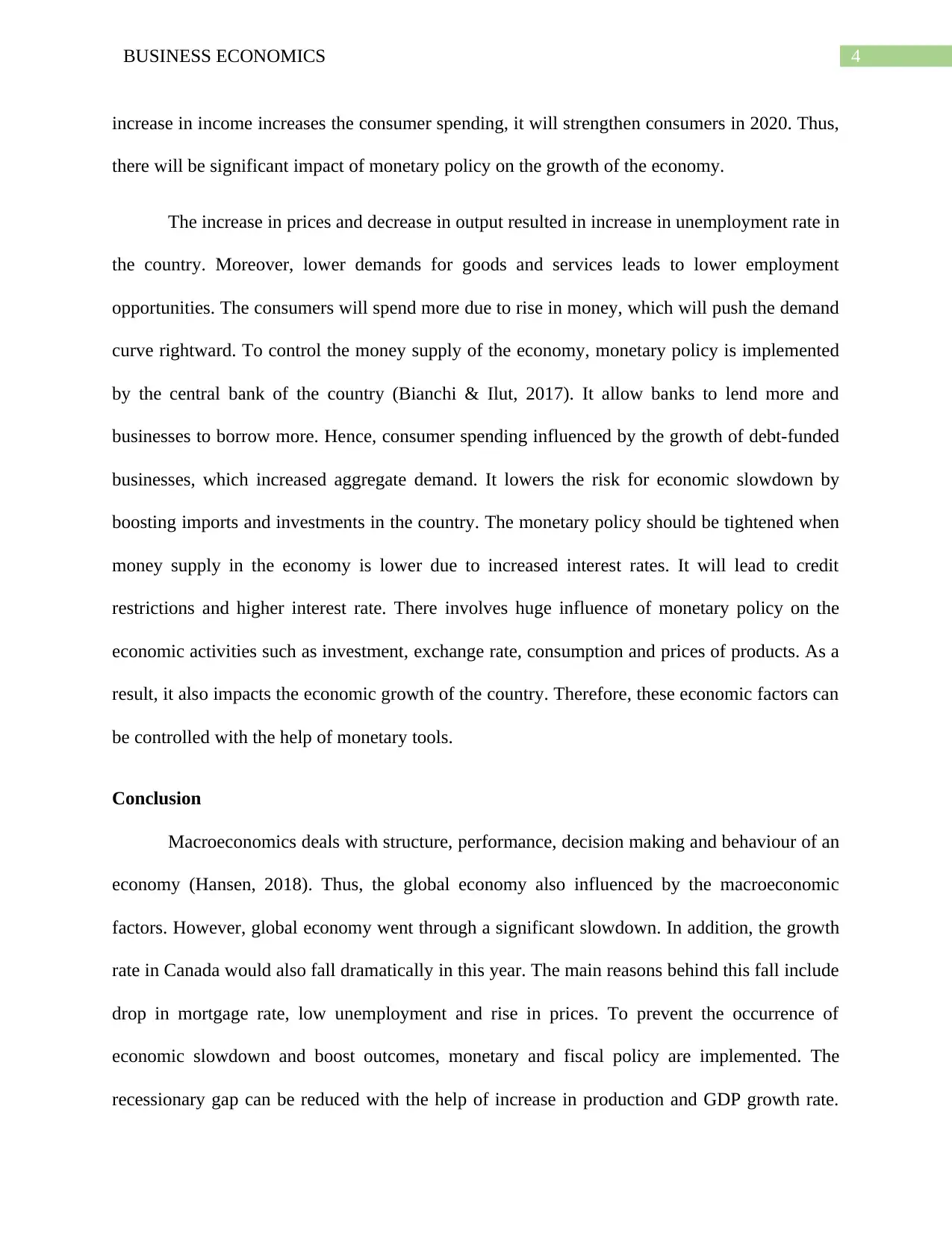
4BUSINESS ECONOMICS
increase in income increases the consumer spending, it will strengthen consumers in 2020. Thus,
there will be significant impact of monetary policy on the growth of the economy.
The increase in prices and decrease in output resulted in increase in unemployment rate in
the country. Moreover, lower demands for goods and services leads to lower employment
opportunities. The consumers will spend more due to rise in money, which will push the demand
curve rightward. To control the money supply of the economy, monetary policy is implemented
by the central bank of the country (Bianchi & Ilut, 2017). It allow banks to lend more and
businesses to borrow more. Hence, consumer spending influenced by the growth of debt-funded
businesses, which increased aggregate demand. It lowers the risk for economic slowdown by
boosting imports and investments in the country. The monetary policy should be tightened when
money supply in the economy is lower due to increased interest rates. It will lead to credit
restrictions and higher interest rate. There involves huge influence of monetary policy on the
economic activities such as investment, exchange rate, consumption and prices of products. As a
result, it also impacts the economic growth of the country. Therefore, these economic factors can
be controlled with the help of monetary tools.
Conclusion
Macroeconomics deals with structure, performance, decision making and behaviour of an
economy (Hansen, 2018). Thus, the global economy also influenced by the macroeconomic
factors. However, global economy went through a significant slowdown. In addition, the growth
rate in Canada would also fall dramatically in this year. The main reasons behind this fall include
drop in mortgage rate, low unemployment and rise in prices. To prevent the occurrence of
economic slowdown and boost outcomes, monetary and fiscal policy are implemented. The
recessionary gap can be reduced with the help of increase in production and GDP growth rate.
increase in income increases the consumer spending, it will strengthen consumers in 2020. Thus,
there will be significant impact of monetary policy on the growth of the economy.
The increase in prices and decrease in output resulted in increase in unemployment rate in
the country. Moreover, lower demands for goods and services leads to lower employment
opportunities. The consumers will spend more due to rise in money, which will push the demand
curve rightward. To control the money supply of the economy, monetary policy is implemented
by the central bank of the country (Bianchi & Ilut, 2017). It allow banks to lend more and
businesses to borrow more. Hence, consumer spending influenced by the growth of debt-funded
businesses, which increased aggregate demand. It lowers the risk for economic slowdown by
boosting imports and investments in the country. The monetary policy should be tightened when
money supply in the economy is lower due to increased interest rates. It will lead to credit
restrictions and higher interest rate. There involves huge influence of monetary policy on the
economic activities such as investment, exchange rate, consumption and prices of products. As a
result, it also impacts the economic growth of the country. Therefore, these economic factors can
be controlled with the help of monetary tools.
Conclusion
Macroeconomics deals with structure, performance, decision making and behaviour of an
economy (Hansen, 2018). Thus, the global economy also influenced by the macroeconomic
factors. However, global economy went through a significant slowdown. In addition, the growth
rate in Canada would also fall dramatically in this year. The main reasons behind this fall include
drop in mortgage rate, low unemployment and rise in prices. To prevent the occurrence of
economic slowdown and boost outcomes, monetary and fiscal policy are implemented. The
recessionary gap can be reduced with the help of increase in production and GDP growth rate.
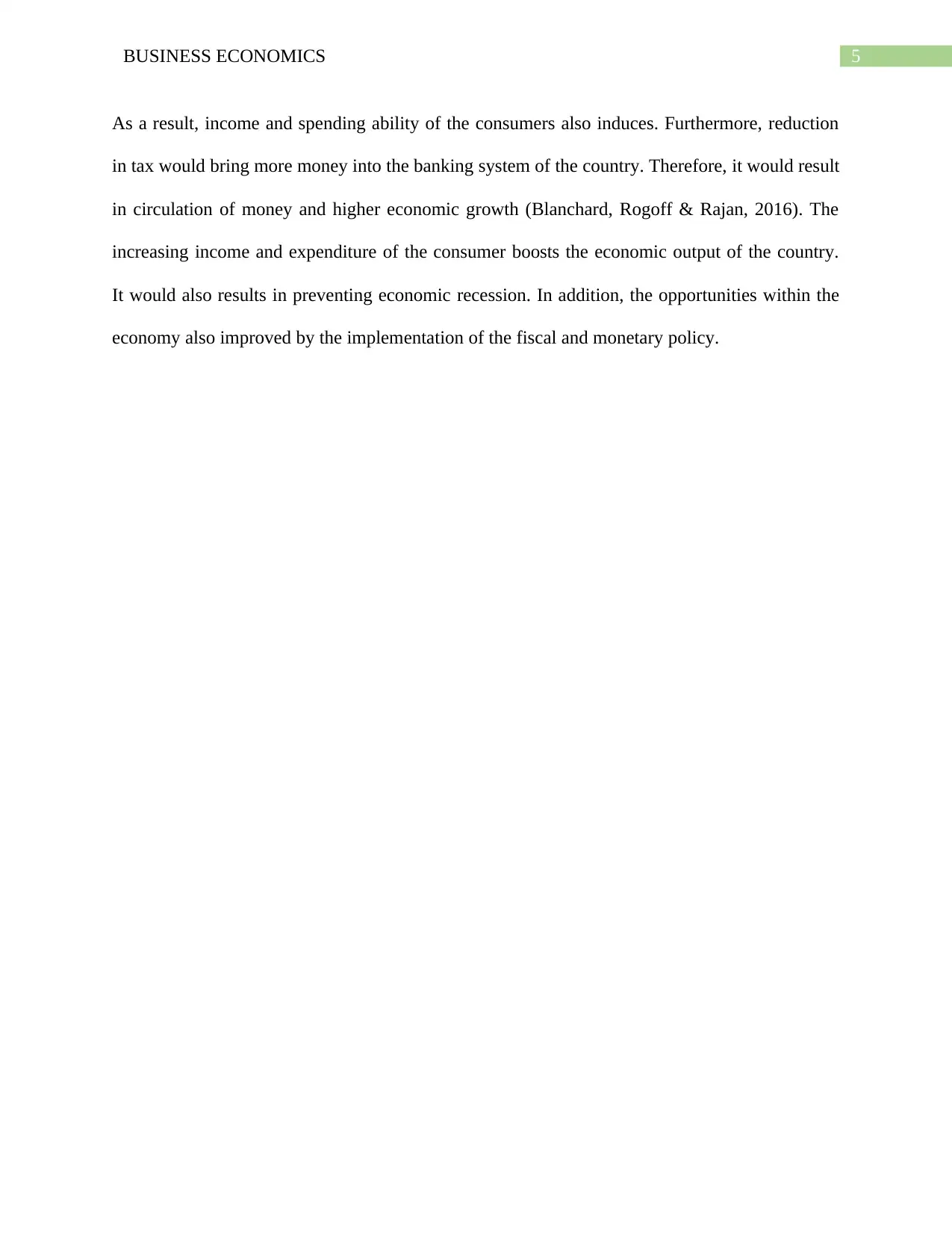
5BUSINESS ECONOMICS
As a result, income and spending ability of the consumers also induces. Furthermore, reduction
in tax would bring more money into the banking system of the country. Therefore, it would result
in circulation of money and higher economic growth (Blanchard, Rogoff & Rajan, 2016). The
increasing income and expenditure of the consumer boosts the economic output of the country.
It would also results in preventing economic recession. In addition, the opportunities within the
economy also improved by the implementation of the fiscal and monetary policy.
As a result, income and spending ability of the consumers also induces. Furthermore, reduction
in tax would bring more money into the banking system of the country. Therefore, it would result
in circulation of money and higher economic growth (Blanchard, Rogoff & Rajan, 2016). The
increasing income and expenditure of the consumer boosts the economic output of the country.
It would also results in preventing economic recession. In addition, the opportunities within the
economy also improved by the implementation of the fiscal and monetary policy.
⊘ This is a preview!⊘
Do you want full access?
Subscribe today to unlock all pages.

Trusted by 1+ million students worldwide
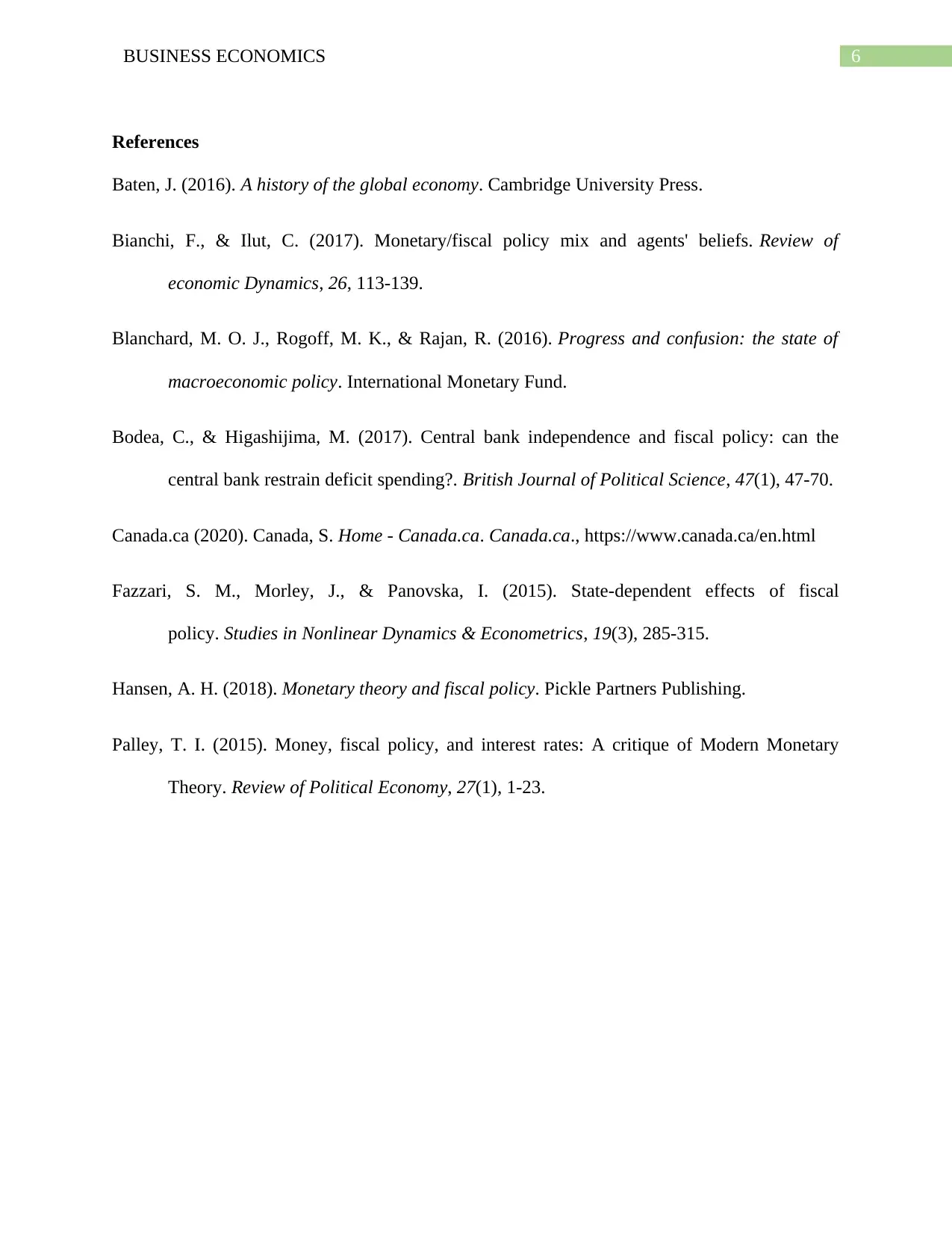
6BUSINESS ECONOMICS
References
Baten, J. (2016). A history of the global economy. Cambridge University Press.
Bianchi, F., & Ilut, C. (2017). Monetary/fiscal policy mix and agents' beliefs. Review of
economic Dynamics, 26, 113-139.
Blanchard, M. O. J., Rogoff, M. K., & Rajan, R. (2016). Progress and confusion: the state of
macroeconomic policy. International Monetary Fund.
Bodea, C., & Higashijima, M. (2017). Central bank independence and fiscal policy: can the
central bank restrain deficit spending?. British Journal of Political Science, 47(1), 47-70.
Canada.ca (2020). Canada, S. Home - Canada.ca. Canada.ca., https://www.canada.ca/en.html
Fazzari, S. M., Morley, J., & Panovska, I. (2015). State-dependent effects of fiscal
policy. Studies in Nonlinear Dynamics & Econometrics, 19(3), 285-315.
Hansen, A. H. (2018). Monetary theory and fiscal policy. Pickle Partners Publishing.
Palley, T. I. (2015). Money, fiscal policy, and interest rates: A critique of Modern Monetary
Theory. Review of Political Economy, 27(1), 1-23.
References
Baten, J. (2016). A history of the global economy. Cambridge University Press.
Bianchi, F., & Ilut, C. (2017). Monetary/fiscal policy mix and agents' beliefs. Review of
economic Dynamics, 26, 113-139.
Blanchard, M. O. J., Rogoff, M. K., & Rajan, R. (2016). Progress and confusion: the state of
macroeconomic policy. International Monetary Fund.
Bodea, C., & Higashijima, M. (2017). Central bank independence and fiscal policy: can the
central bank restrain deficit spending?. British Journal of Political Science, 47(1), 47-70.
Canada.ca (2020). Canada, S. Home - Canada.ca. Canada.ca., https://www.canada.ca/en.html
Fazzari, S. M., Morley, J., & Panovska, I. (2015). State-dependent effects of fiscal
policy. Studies in Nonlinear Dynamics & Econometrics, 19(3), 285-315.
Hansen, A. H. (2018). Monetary theory and fiscal policy. Pickle Partners Publishing.
Palley, T. I. (2015). Money, fiscal policy, and interest rates: A critique of Modern Monetary
Theory. Review of Political Economy, 27(1), 1-23.
1 out of 7
Related Documents
Your All-in-One AI-Powered Toolkit for Academic Success.
+13062052269
info@desklib.com
Available 24*7 on WhatsApp / Email
![[object Object]](/_next/static/media/star-bottom.7253800d.svg)
Unlock your academic potential
Copyright © 2020–2025 A2Z Services. All Rights Reserved. Developed and managed by ZUCOL.





